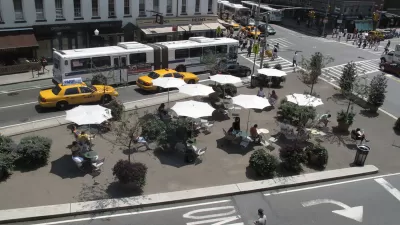Justin Davidson ruminates on the great strides Janette Sadik-Khan and New York's Department of Transportation have made in reforming the city's streets. As much as they've accomplished, the transformation remains a work in progress.
"Making New York’s public spaces safe, civilized, and navigable is a deeply democratic issue," observes Davidson. "If you think that the new street designs are just about giving spandex-encased bikers a high-speed lane of their own or providing tourists with café tables and Wi-Fi, then try shepherding a gaggle of preschoolers across a complicated intersection or pushing a walker across Broadway."
Davidson describes some of the specific elements - from protected bike lanes to curb extensions - that've made New York's streets more accessible to all users. "They’re the work of the Department of Transportation, whose outgoing head, Janette Sadik-Khan, turned an agency devoted to painting bridges and fixing potholes into a platform for social activism."
But reforming the city's streets is "nowhere near complete," he adds. In addition to a backlog of necessary repairs, he identifies several areas of need, including "find[ing] a way for the various ways of getting around the city to coexist more peaceably."
"Faced with the staggering cost of covering basics, the next administration may be tempted to forget the frills. That would be a terrible mistake, because it’s those background tweaks that improve life for everyone in the most democratic part of the city: its streets."
FULL STORY: Pavement As Lab

Alabama: Trump Terminates Settlements for Black Communities Harmed By Raw Sewage
Trump deemed the landmark civil rights agreement “illegal DEI and environmental justice policy.”

Study: Maui’s Plan to Convert Vacation Rentals to Long-Term Housing Could Cause Nearly $1 Billion Economic Loss
The plan would reduce visitor accommodation by 25% resulting in 1,900 jobs lost.

Planetizen Federal Action Tracker
A weekly monitor of how Trump’s orders and actions are impacting planners and planning in America.

Waymo Gets Permission to Map SF’s Market Street
If allowed to operate on the traffic-restricted street, Waymo’s autonomous taxis would have a leg up over ride-hailing competitors — and counter the city’s efforts to grow bike and pedestrian on the thoroughfare.

Parklet Symposium Highlights the Success of Shared Spaces
Parklets got a boost during the Covid-19 pandemic, when the concept was translated to outdoor dining programs that offered restaurants a lifeline during the shutdown.

Federal Homelessness Agency Places Entire Staff on Leave
The U.S. Interagency Council on Homelessness is the only federal agency dedicated to preventing and ending homelessness.
Urban Design for Planners 1: Software Tools
This six-course series explores essential urban design concepts using open source software and equips planners with the tools they need to participate fully in the urban design process.
Planning for Universal Design
Learn the tools for implementing Universal Design in planning regulations.
Caltrans
Smith Gee Studio
Institute for Housing and Urban Development Studies (IHS)
City of Grandview
Harvard GSD Executive Education
Toledo-Lucas County Plan Commissions
Salt Lake City
NYU Wagner Graduate School of Public Service



























